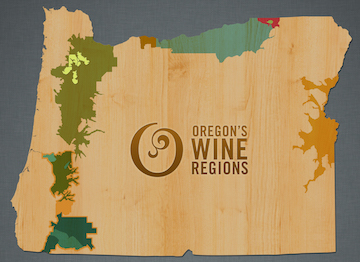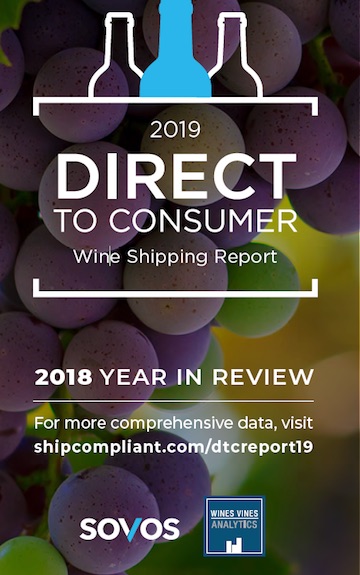The Oregon Wine Industry’s Direct Shipping Success Story
 The 2019 SOVOS/Wines & Vines Direct To Consumer Wine Shipping Report was released today and it showed that, once again, Oregon wineries are outpacing other regions in growth of wine shipped direct to the consumers. Overall in 2018, all American wineries increased the volume and value of their DTC shipments by 8.9% and 11.6 percent, respectively. Oregon wineries increased their volume and value of shipments by 19% and 21%. Ladies and gentlemen, can I get a Hoorah!
The 2019 SOVOS/Wines & Vines Direct To Consumer Wine Shipping Report was released today and it showed that, once again, Oregon wineries are outpacing other regions in growth of wine shipped direct to the consumers. Overall in 2018, all American wineries increased the volume and value of their DTC shipments by 8.9% and 11.6 percent, respectively. Oregon wineries increased their volume and value of shipments by 19% and 21%. Ladies and gentlemen, can I get a Hoorah!
What this means, at the least, is that Oregon wineries are seeing an increase in visitors to their tasting rooms. This is born out by the survey of wineries conducted by Silicon Valley Bank and outlined in their recently released 2019 Wine Report. Winery visits are the holy grail of small winery sales: getting people on site, showing and presenting your wines, selling the wines, and bringing in more wine club members is the name of the game. Oregon has been doing this better than most other wine regions according to the SOVOS/Wines & Vines Shipping Report.
Why?
There are a number of reasons Oregon wineries are performing so well in the DTC shipping channel. But first, it’s important to recognize that DTC shipments are an excellent proxy stat for overall DTC sales. There is a difference. Only a portion of sales to consumers from the winery is actually shipped. That percentage is different from region to region. But when you see a state like Oregon outperforming the overall DTC shipping channel year in and year out, you know that they are also overperforming in the DTC winery sales category. Again, there are a number of reasons for this:
1. Proximity to and easy access from a major metropolitan area.
The importance of the Willamette Valley’s proximity to Portland can’t be underestimated. Although Napa’s  reputation drives millions of people to that region, those people wouldn’t be arriving there in such numbers if it were not easy to get to from the Bay Area. It’s an hour or so away from San Francisco, Oakland and Sacramento. The same is true for Oregon’s Willamette Valley, and particularly the Northern Willamette Valley.
reputation drives millions of people to that region, those people wouldn’t be arriving there in such numbers if it were not easy to get to from the Bay Area. It’s an hour or so away from San Francisco, Oakland and Sacramento. The same is true for Oregon’s Willamette Valley, and particularly the Northern Willamette Valley.
2. The Price-Quality Ratio is Very Good in Oregon
According to the SOVOS/Wines & Vines 2018 DTC Shipping Report, the average price per bottle shipped to consumers from a Oregon winery is $39.70. While this is far higher than most other regions tracked in the report, it doesn’t begin to approach the $67.10 average price per bottle shipped from Napa wineries. Yet, the perceived quality of Oregon wines is very high. Wine Opinions performed a survey of high frequency/high-end wine consumers in 2015 asking them to rank the Willamette Valley, Oregon and other wine regions for wine quality. Willamette Valley performed extremely well. And that was back in 2015. Since then I believe it’s safe to say that the perception of quality of Oregon wines has increased measurably. It also ought to be noted that in 2018, according to the new SOVOS/Wines & Vines DTC Report, the average price per bottle of wine shipped from any Oregon winery increased by 1.4%, much less than the national average increase in price per bottle shipped of 2.4%.
3. Promotion
The city of Portland has engaged in some very smart, entertaining and effective destination promotion that has been of great benefit to Oregon wineries. Add to this the impressive work of the Oregon Wine Board and you have a great one-two punch that not only draws more people to the Willamette Valley and beyond, but also raises the profile and perception of Oregon wine.
Population
People are still moving to Oregon in numbers much greater than those moving out (raises hand!). According to the U.S. Census Bureau, Oregon’s population has increased by 9.4% since 2010, ranking it number 12 among the 50 states and District of Columbia. With more people come more purchases of local products, and that includes wines, local wines.
There are a few other interesting notes from the SOVOS/Wines & Vines 2018 DTC Report. Consider Rosé.
Shipments of Rosé from Oregon wineries in 2018 increased by 53% over 2017. Rosé is now the 5th most commonly shipped wine in Oregon after Pinot Noir, Chardonnay, Red Blends and Pinot Gris. Meanwhile, Sauvignon Blanc actually performed best over 2017 with an 85% increase in volume and 103% increase in value. However, SB still represents only 1% of all shipments.
And let’s talk about the flagship. Pinot Noir DTC shipments increased 15% by volume and 18% by value over 2017. Two-thirds of the entire value of the Oregon DTC shipping channel accrues to Pinot shipments. This is down only slightly from 2011, when Pinot Noir shipments represented 71% of the value of Oregon DTC shipments.
So is everything Roséy for Oregon (sorry!)? I’d point to certain headwinds. The Millennial generation is not engaging with premium wines at the rate we’d like them to, while the better off Boomers are going to be quickly withdrawing from the wine buying market. In addition, there is caution being recommended where the overall American economy is concerned. Then there is the issue of labor. It’s tight. This is only going to increase costs for Oregon wineries.
Where direct to consumer sales are concerned, Oregon is on a roll. By leading with world-class Pinot Noir as it greets visitors from around the country and globe who flew into Portland and as it serves its growing population with premium priced wines that are matched by very high quality, there is every reason to believe the state’s wines ought to continue to attract attention and dollars.
_________________________________________________________________
Disclosure: Tom Wark contributed to the 2019 SOVOS/Wines & Vines Direct to Consumer Shipping Report

I submit that one of the reasons DTC sales are up in Oregon is the wholesale distribution channel is crumbling for small producers. I had two of my distributors go bankrupt last year! Another dumped me to keep their biggest supplier (who had expanded its Oregon holdings) happy, etc., etc.
For most small producers (and Oregon has plenty) it’s DTC or bust.
Fortunately, consumers are recognizing that if they want to get their hands on limited production wines from Oregon, they’re going to need to visit the region and/or join a wine club.